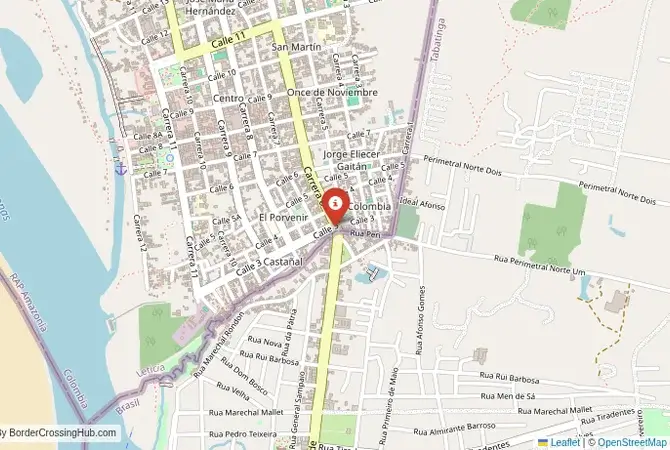
Approximate Border Location
Wait Times
30-60 min for pedestrians/boats
Operating Hours
Open 8:00 AM – 5:00 PM
Crossing Types
Pedestrians, boats
Border Type
Land crossing via river
Peak Times
Mornings (8-11 AM)
Daily Crossings
~2000 travelers/vehicles
Currency Exchange
Available near Tabatinga (BRL, COP)
Safety Information
Generally safe, river navigation
Languages Spoken
Portuguese, Spanish
Accessibility Features
Ramps
About Leticia & Tabatinga
A River Crossing in the Triple Frontier
The border crossing connecting the Brazilian city of Tabatinga with Leticia in Colombia is a journey into one of the most unique and iconic locations in all of South America: the “Tres Fronteras” or Triple Frontier. This is not a bridge or a highway; it is an open, urban border where a single street, Avenida da Amizade (Friendship Avenue), is the only thing separating two nations. To cross here is to simply walk from one side of the street to the other. It is a passage within a vibrant, chaotic, and culturally fascinating tri-national metropolitan area that also includes the Peruvian village of Santa Rosa de Yavarí, just a short boat ride away. It is a journey into the very heart of the Amazon rainforest, a place where the border is a fluid, almost imaginary line.
Operational Details
This checkpoint connects Brazil’s Amazonas state with the Amazonas Department of Colombia. There is no single, mandatory checkpoint for moving between the city centers. People cross freely for shopping, work, and daily life. However, formal immigration offices exist in both towns for travelers who need to officially enter or exit the country—a crucial step for anyone not just visiting for the day. The Brazilian Federal Police office is in Tabatinga, and the Colombian immigration office (Migración Colombia) is located at the Leticia airport. The movement between the three cities is largely unrestricted for locals and tourists making day trips, but formal stamping is essential for those traveling further into either country.
Before Crossing
Crossing borders gets messy sometimes, think political flare-ups or gates shutting fast. Good travel insurance is a must for handling doctor visits, trip disruptions, or security scares. Don’t get caught unprepared. To find a policy that’s got your back, check out reliable plans today for peace of mind.
A History of a Remote Hub
The history of this region is the history of the Amazon River and the indigenous peoples who have inhabited its banks for millennia. The modern cities were established in the 19th and 20th centuries, largely driven by the rubber boom and geopolitical interests. The borders were drawn through this remote jungle, creating a unique situation where three countries meet. The Colombian city of Leticia is the largest and most developed of the three, and it functions as the commercial and tourist hub for the entire region. The three cities, despite being in different countries, function as a single, integrated community, with a shared economy and a constant flow of people, goods, and languages.
The Unique Border Procedure
The border crossing procedure is unique and requires proactivity from the traveler. You can freely travel between the three towns without showing your passport. However, if you are officially entering or leaving Brazil or Colombia, you must make a dedicated trip to the immigration offices. For example, to travel from Brazil to other parts of Colombia, you must first get a Brazilian exit stamp in Tabatinga, then walk across the street to Leticia and go to the airport to get a Colombian entry stamp. It is a multi-step process that can be confusing for the unprepared traveler. The Peruvian immigration office is a boat ride away in Santa Rosa.
The Surrounding Region: Brazil Side
On the Brazilian side, Tabatinga is a bustling, gritty military and port town. It is the main gateway to the vast indigenous territories of the Alto Solimões region. The city has a lively market and is a major hub for the Brazilian army’s jungle operations. The main attraction is its role as part of the vibrant Tres Fronteras area and its connection to the Amazon River. It is the end of the line for the multi-day ferry journey up the Amazon from Manaus.
The Surrounding Region: Colombia Side
On the Colombian side, Leticia is the capital of the Amazonas department and the main hub for tourism in the Colombian Amazon. The city has a lively market, a beautiful park (Parque Santander) where thousands of parrots come to roost every evening in a spectacular natural display, and is the departure point for numerous jungle lodges and eco-tours. Visitors can explore the nearby indigenous communities of the Tikuna, Yagua, and Cocama peoples, go piranha fishing, or take a night safari to look for caimans. The Amacayacu National Natural Park is also in this region.
Practical Travel Information
Practical planning is essential. Remember to get your passport stamped if you are officially entering or leaving a country. The official currencies are the Brazilian Real (BRL), the Colombian Peso (COP), and the Peruvian Sol (PEN), and all three are widely accepted throughout the tri-border area. Be aware of your personal security, especially in the port areas. Be aware of the health risks of travel in the Amazon, including mosquito-borne diseases, and take appropriate precautions. The only way to arrive or leave this region is by plane (to Leticia or Tabatinga) or by a multi-day boat journey.
Final Considerations
The Tabatinga–Leticia border crossing is a journey into the heart of the Amazon. It is a unique and unforgettable experience, a passage that is defined by the great river that serves as both a border and a bond. It is a place where three nations and countless indigenous cultures meet and mingle in a vibrant, chaotic, and beautiful frontier town. For the adventurous traveler, it is a gateway to the wonders of the Amazon, a starting point for an epic river journey into the largest rainforest on Earth.
No reviews yet.
